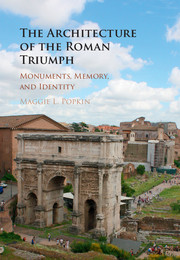Book contents
- Frontmatter
- Dedication
- Contents
- List of Figures
- List of Tables and Color Plates
- Acknowledgments
- INTRODUCTION: THE TRIUMPH, MEMORY, AND “BEING ROMAN” IN THE CITY OF ROME
- 1 THE TRIUMPHAL ROUTE
- 2 BUILDING MEMORIES: THE ERA OF THE PUNIC WARS (264–146 B.C.)
- 3 SPECTACLE AND MEMORY: THE REIGN OF TRAJAN, OPTIMUS PRINCEPS (A.D. 98–117)
- 4 MONUMENTS AND MEMORY DISTORTION: THE REIGN OF SEPTIMIUS SEVERUS (A.D. 193–211)
- CONCLUSION
- Appendix Victory Monuments Built along the Triumphal Route during the Punic Wars: Topography, Dating, and History
- Notes
- References
- Index
- COLOR PLATES
CONCLUSION
Published online by Cambridge University Press: 05 July 2016
- Frontmatter
- Dedication
- Contents
- List of Figures
- List of Tables and Color Plates
- Acknowledgments
- INTRODUCTION: THE TRIUMPH, MEMORY, AND “BEING ROMAN” IN THE CITY OF ROME
- 1 THE TRIUMPHAL ROUTE
- 2 BUILDING MEMORIES: THE ERA OF THE PUNIC WARS (264–146 B.C.)
- 3 SPECTACLE AND MEMORY: THE REIGN OF TRAJAN, OPTIMUS PRINCEPS (A.D. 98–117)
- 4 MONUMENTS AND MEMORY DISTORTION: THE REIGN OF SEPTIMIUS SEVERUS (A.D. 193–211)
- CONCLUSION
- Appendix Victory Monuments Built along the Triumphal Route during the Punic Wars: Topography, Dating, and History
- Notes
- References
- Index
- COLOR PLATES
Summary
The Roman triumph was a ritual whose performance, along with its history, was constantly invented and reinvented. Yet despite its vicissitudes, the triumph persistently connected monuments, urban space, ritual, and Roman identities. Indeed, the relationship between the ritual and the monuments of the triumphal route is a large part of what enabled the triumph to survive across the ages even as it was reinvented and transformed. It has been the central aim of this book to show how powerfully monuments shaped how Romans performed, experienced, and remembered triumphs across centuries.
Studying the monuments of the triumphal route through the lens of their effect on experience and remembering also enables us to consider both patron interest and reception throughout manifold stages of Roman history. A combination of inspiration on the part of a building's designers and on the part of the patron produced the visual aspects of each monument discussed in the present work. Roman generals and emperors thought of buildings as their signature contribution; as Pliny the Elder writes, “… in our buildings we have vanquished the world.” The large dedicatory inscriptions that appear on buildings, such as the Pantheon, but not on statues and wall paintings, confirm how important architectural dedications were in the eyes of their dedicators. The concept of patron interest and intent, not new to the study of Roman architecture, is, therefore, of great importance here. Equally important, however, is the perception and reception of these monuments by people living in Rome. How any given individual received a monument is beyond the grasp of scholars, but considering the cognitive processes of human remembering enables us at least to hypothesize in a more informed manner about the range of responses and associations that monuments might have evoked in various Roman observers, depending upon the memory communities to which they belonged and the various discrepant identities with which they affiliated themselves.
We cannot fully understand why the triumph was such a meaningful institution in Roman society unless we consider its monumental context and the impact of this architecture on how Romans experienced and remembered triumphs. In many ways, the triumph and the triumphal route cry out for a consideration of memory studies.
- Type
- Chapter
- Information
- The Architecture of the Roman TriumphMonuments, Memory, and Identity, pp. 182 - 186Publisher: Cambridge University PressPrint publication year: 2016



